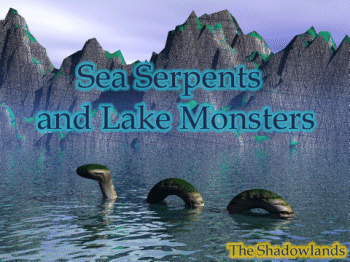 |
 |
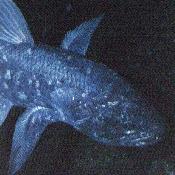
Any
information
on creatures not listed here and pictures can be sent to me at davejuliano@theshadowlands.net.
If you have pictures, text, video, etc., that you would like us to add
to the page but don't know to put it on the computer, let us know, we
can
scan and video capture images for you. We
are also looking for amateur or professional researchers who want to
join
the staff here at The Shadowlands, send us an email
for info.


![]() "Sea
Monster" Sighting Reported by Nova Scotia Fisherman
"Sea
Monster" Sighting Reported by Nova Scotia Fisherman
![]() "Cressie"
Sighted in Newfoundland
"Cressie"
Sighted in Newfoundland
![]() Plesiosaur
Fossil Found in Loch Ness
Plesiosaur
Fossil Found in Loch Ness
![]() Lake
Tianchi Monster Surfaces in China
Lake
Tianchi Monster Surfaces in China
![]() Sea
extended to Loch Ness at times
Sea
extended to Loch Ness at times
![]() Giant
Octopus Article
(picture)
Giant
Octopus Article
(picture)
![]() Strange
Life Form Found in Ocean
Strange
Life Form Found in Ocean
![]() Giant
Octopus Dredged Up Off New Zealand
Giant
Octopus Dredged Up Off New Zealand
![]() Giant
Sturgeon found in Florida
Giant
Sturgeon found in Florida
![]() Hunt
for Undersea Giant Kraken Underway
Hunt
for Undersea Giant Kraken Underway
![]() Ogopogo
(pictures)
Ogopogo
(pictures)
![]() Sea
Serpents of the Pacific Northwest
Sea
Serpents of the Pacific Northwest
![]() Colossal
Claude and Marvin the Monster
Colossal
Claude and Marvin the Monster
![]() Recent
Coelacanth info 9-23-00
Recent
Coelacanth info 9-23-00
![]() Monster
Squid found in the Antarctic
Monster
Squid found in the Antarctic
![]() Lake
Monster Has Price on Head
Lake
Monster Has Price on Head
![]() Bizarre
Marine Mammal in France
Bizarre
Marine Mammal in France
![]() Lake
Van (2 videos)
Lake
Van (2 videos) 
![]() Cadborsaurus
(Caddy) (sketch)
Cadborsaurus
(Caddy) (sketch)

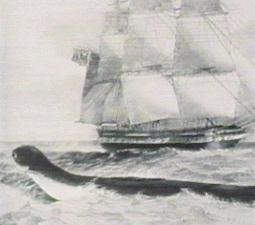
August 6, 1848, on board the Daedalus in the Atlantic Ocean, 7 men including the Captain reported seeing a creature about 60 ft long and 15 inches in diameter. A mane of a soft looking material flowed down it's back. The creature's body was a dark brown in color and it's throat area was a yellowish white. The creature was swimming approximately 15 MPH with its head constantly above the water. In modern times a creature matching this description has been seen off the coast of California by many reputable witnesses.
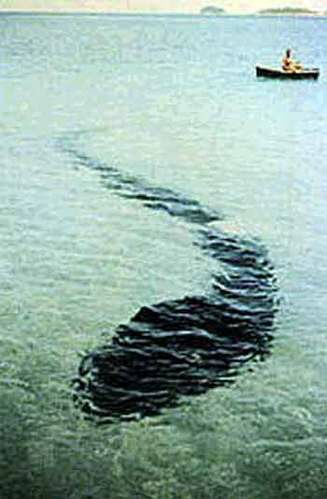
December 12, 1964, French photographer Robert Serrec was vacationing in Queensland, Australia. He was out off the coast in small row boats with his family and friends. They were in less than 6 feet of water when they noticed a giant snake like creature laying on the oceanbottom. They describe it as a grayish tadpole like creature with a snake like head, approximately 75-80 feet long. There appeared to be a large wound on the creatures back. They took pictures of the creature before it became bothered and swam off. (see above pic)
1961, Mrs. Stoudt of Oregon and her
sister were walking their children along the Strait of Juan de Fuca
in Washington
State, when they saw what first appeared to be a tree limb in the
water. As the object moved closer to them they described
seeing
a creature which had a snake like head, floppy mane, and 3
humps.
It disappeared from view only to resurface closer to them. They
said
it looked like some sort of dinosaur. It appeared to be watching
the passing ships, then it moved even closer to their position which
caused
one of the children to cry. The creature turned and looked at
them
and then swam off.
Chessie, as it has come to be known, is the frequently sighted creature of the Chesapeake Bay area. The creature has been sighted in this area regularly since the 19th century. It's described as being a long, dark, serpent like creature. In 1982, Robert Frew filmed Chessie from a house on Kent Island which overlooked the bay. Frew and his wife spotted the creature in shallow, clear water about 200 yards from the house. He video taped the creature as it swam toward a group of swimmers. It dove beneath the swimmers and reappeared on the other side of them. The creature they saw was about 30-25 feet long, 1 foot in diameter, dark brown with a humped back. In 1978, a retired CIA employee, Donald Kyker, reported seeing Chessie and 3 others about 75 yards off shore. His neighbors, the Smoots', also witness the creatures. They gave descriptions of a 30 ft, sleek, dark gray creature swimming about 7-8 miles per hour.
Sightings of Chessie have remained pretty consistent and occur more frequently May through September. This could be due to the increase in people in the area during these times or possibly a migration of this creature. Some of the best places to observe Chessie are Love Point at Kent Island, the mouth of the Potomac river and Eastern Bay. The witness list includes quite a few people whose integrity and observation skills are above reproach, such as coast guard and naval officers, airline pilots, ex-CIA official and a FBI agent. The photos and film that exist of Chessie were studied by Smithsonian Officials and they concluded that it was a living animal that was pictured, but they could not identify it.
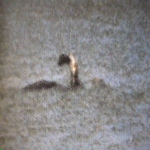
Lake Champlain, is a lake that is
109
miles long on the boarders of New York and Vermont. A French explorer
by
the name of Samuel De Champlain has been given the distinction of being
the first individual to see the North American lake monster in Lake
Champlain.
This is reported to have develop in the year 1609, but this may not
have
been the first sighting of the lake monster that
has come to be known as CHAMP.
A journalist in the 1960’s found that the sighting may not have been in the lake at all ,that it is more likely that the first sighting of the lake monster was off the coast of the St. Lawrence estuary. In all likelihood the first sighting of the lake monster in the lake itself, took place at Port Henry, New York in 1819 by settlers in the territory. It was again noted at an locus that became known as Dresden, New York in the first part of the seventeenth century. The sightings continued and in 1883, the Sheriff of Clinton County Nathan Mooney delineated witnessing a “ an enormous snake or water serpent 25 to 30 feet in length”. In 1899 a group of men fishing saw something slightly leave the water and move up the shore line.
Sandra Mansi, was vacationing in
Vermont
not far from the Canadian Boarder. When the lake monster made its
presence
known to Mrs. Mansi & her husband. They had the presence of mind to
get a camera and took a picture of Champ. The picture was analyzed and
it was concluded that it was not a fallacy. From this picture it has
been
speculated that the lake monster may be a creature known
as a plesiosaur, which lived many
centuries
ago.
Lake Champlain would be ideal, It has depths of up to 400 feet and a outlet to the Atlantic ocean. The food is presence to support such a creature or creatures for centuries. Lake Champlain also has a water temperatures that is ideal for the sanctuary of such a creature as well as underwater archeology sites
In recent years a smaller creature has been seen with the large one. The research continues in Lake Champlain and only time will give us the answers that we seek. This creature was photographed in Lake Champlain.
by Bernard W. Kelly Sr.
(SWPSRG1@aol.com)
Could there be a family of these
creatures
in the lake reproducing and continuing their yet unknown species all
these
years. It is assumed by many scholars that these
mysterious
creatures must reproduce in order to cover the time span of their
sightings.
For example, Nessie has been seen by reliable witnesses for 100's of
years.
We must assume, therefore, that there is a family of breeding creatures
in the loch, and in Lake Champlain as well. There have been 130
verified
reports of sightings as of 1982. You can get more info on Champ here
.
Update 2-22-06:
Is There a Monster in Lake Champlain?
ABC News
Feb. 22, 2006 — Residents near Lake
Champlain in New York say they have their own Loch Ness monster. They
call it Champ, and it's a local legend.
It is the inspiration for parade floats, T-shirts, key chains,
minor-league baseball team mascots, and wild stories.
ABC News obtained exclusive video of something just under the surface
of the lake that some say may be Champ. The video was taken by two
fishermen with their digital camera last summer. Before their supposed
sighting, they were Champ skeptics.
"It was as big around as my thigh," said fisherman Peter Bodette. "I'm
100 percent sure of what we saw. I'm not 100 percent sure of what it
was."
"It made my hair stand on end at the time," said fisherman Dick
Affolter. "It just didn't fit anything — any creature I had seen."
Affolter said they never saw the entire body.
"What we saw always stayed at the surface and parts of it would come
above the water, like the back of the nose or the head," he said.
In the past, grainy pictures and home video taken from too far away did
not provide a clear picture. This footage — showing an odd wake — is
from a closer vantage point, but still not clear.
Lake Champlain Lore
So far, there have been hundreds of sightings — sometimes more than a
dozen a year — of Champ.
"There are people who say they've seen something unusual in the lake,"
said Lohr McKinstry, a reporter for the Press Republican, who has been
writing about Champ sightings for more than 20 years. "Some sort of
unusual life that shouldn't be there in Lake Champlain. Best guess
would be that it is some sort of creature that possibly should be
extinct."
The Champ frenzy began in the 1880s when P.T. Barnum offered $50,000
for the capture of Champ dead or alive. Hunters and fishermen came out
of the woods, but no one was able to collect.
As for the latest sighting, two retired FBI analysts reviewed the tape
and said that it appeared authentic.
"I can't find anything in there that would suggest or indicate to me
that this has been fabricated or manipulated in any way," said Gerald
Richards, a forensic image analyst. "However, there's no place in there
that I can see actually see, an animal or any other object on the
surface."
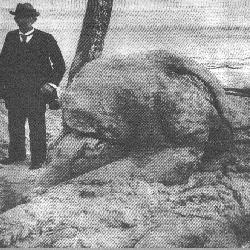
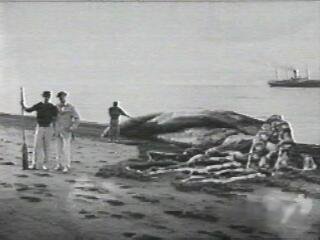
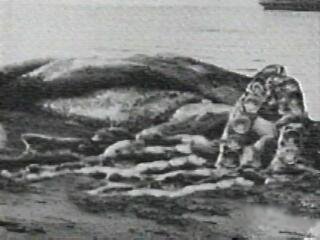
The Lusca is a creature that the people of the Bahamas have seen for years. It matches the description of a giant octopus. Is that possible ? Pictured above are the remains of a unknown species of giant octopus ? While we know that giant squids do exist, it has never been confirmed that a giant octopus does, in fact, exist. The octopus would be more likely to attack ships and sailors than a squid would, so if there is a giant variety of the species, this could add credibility to stories of giant squid/octopus' attacking ships. The Kraken was a sea serpent that was seen by thousands of sailors. The Kraken description matches that of the giant squid. How many "Kraken" attacks were the work of an giant octopus ? An estimate on the size of the corpse in the picture if it was an octopus would make the octopus 150 to 200 feet tip to tip of the tentacles. The cell samples of the corpse were taken to the Smithsonian Institute in Washington DC and tested. The cells of the creature were not identical to, but very closely resembled the octopus more than any other type of sea creature.
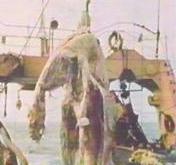
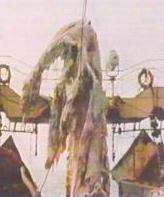
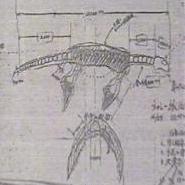
This carcass was picked up by the Japanese fishing boat MS Zuiyomaru off the coast of Japan. The carcass was covered with a fatty tissue which had badly decayed. The creature weighed about 1 ton. The Captain ordered it thrown back because of it's smell so it was never closely examined. Scientists studying the picture were unable to tell what kind of animal it was. It does not resemble any known sea dwelling creature. Skeptical scientists assumed it was a decayed body of a basking shark. Upon further examination, other biologists claim the size, fin placement, and overall appearance does not support the basking shark theory. The sketch shown above is a drawing of what the creature would look like laid out flat.
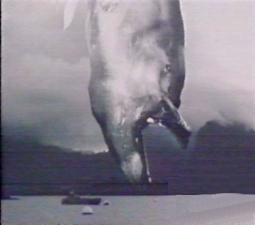
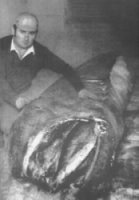
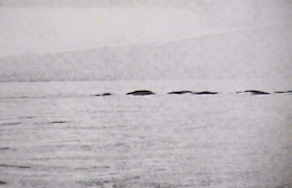
The creature that has been sighted in Canada's Lake Okanagan is known to the locals as Ogopogo. This creature is considered the Nessie of North America. The numerous sightings date back to 1850 and still continue to this day. The creature is described as a large, dark colored animal with a long neck and a humped back. In 1968, Art Folden video taped Ogopogo while it swam across the lake. In 1976, the above photo was taken of Ogopogo by Ed Fletcher of Vancouver. On that day he chased the creature up and down the lake for several hours taking pictures of it. More info Here.
The White River runs through a town in Arkansas called Newport. From 1915 to present day the residents have reports seeing a mysterious creature in the river. The creature has been seen thrashing about in the river and is described as being 12 to 30 ft long and about 5 ft wide. Three toed tracks have also been found on the river banks. The prints measure 14 in. long and 8 in. wide. Theories on the identity of the creature range from an out of place elephant seal to a giant penguin.
New Comments from Jan Hoover who is
a ichthyologist (fish biologist)
"I believe that the White River Monster
is a series of sightings of groups of paddlefish, combined with an
occasional
sighting of a large (possibly ill) sturgeon. The Monster is
described
as a surface dwelling, oceanic looking animal with smooth gray skin, a
large mouth, and a long bone projecting from its head. Only the
size
is inconsistent with a paddlefish (Polyodon spathula), but
paddlefish
frequently occur in large groups near the surface of the water and this
could be responsible for the exaggerated size. Anyway, its a much
more credible candidate than a lost seal, etc., since paddlefish occur
naturally in the White River."
More info coming soon
In 1969 the M/V Mylark, a shrimp boat fitted with special equipment, was using a state of the art electronic detector to map the ocean bottom in the Raspberry Straight off Kodiak, Alaska. The detector was the Simarad which was an fool-proof electronic detector. What the also detected about 55 fathoms down was a 200 ft long "dinosaur". This assignment had nothing to do with marine life so they were not in search of any, yet they had managed to get an image of a very large marine creature that did not resemble any known animal in the area. There are no whales in this area that are this size and shape.
On the morning of November 1 1922, visitors to the beach at Margate, South Africa, were treated to an amazing spectacle out at sea: two whales could be clearly observed engaging in battle with a bizarre sea monster with snowy-white fur and a huge elephantine trunk.As the titanic battle progressed,the monster seemed to weaken, and three hours later it was dead.During the evening it's lifeless body was washed ashore and proved to be truly colossal, measuring just over 14 metres(47 feet) in length,and including a 3 metre (10 foot) tail.Apart from it's luxuriant 20-cm (8-inch) long fur,however, the most remarkable feature abou this creature is that it did not possess a distinct head; instead, it bore only the trunk-like appendage, 1.5 meters (5 feet) long, that had been visible during it's fatal encounter with the whales.This creature was dubbed "Trunko".
sent in by Socrdude86@aol.com
Alkali Lake is located in Nebraska. The Indians of this area told the white settlers of a creature dwelling in the lake. In 1923, J.A. Johnson reported in the Omaha World-Herald that he, along with 2 friends, saw the creature. He also states that he knew of 40 others who had also seen the animal. The 3 saw the creature while camping near the lake. The saw the creature 3/4 out of the water and about 20 yards away. They described the creature as being 40 ft long, dull gray/brown and a horn-like object between it's eyes and nostrils. They said it looked similar to an alligator but was bigger and heavier than an alligator. When the creature noticed the men, it thrashed it's tail about and then dove under the water.

Illiamna Lake in located in Alaska. This lake is 80 miles long and it boasts numerous unknown creatures dwelling in it's waters. While the sizes vary in the descriptions, the creatures are described as being grayish, broad headed, with long bodies and vertical tails. The sightings of these animals date back to the Indians living in this area. They feared the creatures and claimed that the animals had attacked and killed boaters on the lake. Pilots flying over the lake have seen the creatures sitting just below the waters surface. One theory is that these creatures are Beluga whales that have entered the lake from the sea. The residents of the area say they know what beluga whales look like since they are common sights, these creatures do not remotely resemble the Beluga whale.
More info: http://www.ncf.carleton.ca/~bz050/iliamna.html
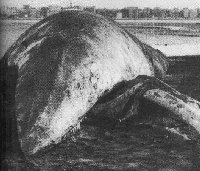
This unknown animal washed ashore after a 3 day violent storm in Ataka, Egypt in 1950. The creature has yet to be identified by marine biologists or zoologists.
Lake Tahoe, California is the home to a water creature known to the locals as Tessie. The snake-like creature is said to be over 60 feet in length with dark skin. There has been video tape of the creature swimming in the lake. The Washoe Indians had stories in the 1800's of a similar creature inhabiting the lake.
For the past 30 years there have
been
reports of a unknown creature living in Lake Erie. The locals
have
named it South Bay Bessie. The creature is described as snake like and
about 30/40 ft long with a grayish color. Numerous sightings by
boaters
on the lake have been recorded and sightings still continue there
today.
The creature is blamed for an attack and deaths of 3 people in
1992.
The survivors of the attack said the head of the creature was the size
of a car. There is a reward for the humane capture of a living
Bessie.
Peter Ciams, "Colossal Claude and The Sea Monsters," The Oregonian. September 24, 1967.
Until about 20 years ago Oregon also seemed to be wonderful country for serpent seekers. The following story by Peter Caims appeared in the September 24, 1967 edition of the Oregonian:
Colossal Claude hasn't been seen for some time, but Marvin the Monster is reportedly alive and well. He's even appeared on television.
Claude was first seen cavorting near
the mouth of the Columbia River in 1934. Over the years he was often
sighted
by Columbia River lightship crewmen and by passing fishermen. But the
once-familiar
sea serpent hasn't shown up since the mid-1950s-
Marvin is a comparative newcomer.
He was first discovered swimming off the Oregon Coast by Shell Oil Company divers in 1963. His presence was recorded by video tape cameras, later screened for study by the nation's leading marine biologists.
In addition to Claude and Marvin, the watery denizens have been sighted off Newport, Bandon, Nelscott, Waldport, Empire, Delake and also in Crescent and Crater Lakes.
They come in several varieties and sizes. Some are shiny and some have scales. Some reportedly have coarse fur. There is even a variety of mini-monster, for the compact minded.
One thing they usually have in common is the shape of their heads. Observers say they are most often found to be like those of the camel, or horse.
L.A. Larson, mate of the Columbia River lightship, was probably the first to see Claude. That was back in 1934. Other members of the crew confirmed the sighting as did the captain and members of the crew of the lightship tender Rose.
"It was about 40 feet long," and Larson. "It had a neck some eight feet long a big round body, a mean looking tail and an evil, snaky look to its head."
A news story of the day reported:
"Members
of the crew (of the lightship) after studying the monster for some time
with field glasses, wanted to lower a boat and go after it, but the
officers
discouraged the plan for fear it would swamp the boat."
Claude next popped into the news in
1937, when skipper Charles E. Graham of the troller Viv raced back to
Astoria
with the story of sighting a "long, hairy, tan colored creature, with
the
head of an overgrown horse, about 40 feet long, and with a 4-foot waist
measure."
Veteran fishermen gazed out over the Columbia bar and said: "It's Claude.
Claude was repeatedly sighted through the years that followed. Once by Captain Chris Anderson of the schooner Arpo. He said he got a face to face look at Claude.
"His head was like a camel's," he said. "His fur was coarse and gray. He had glassy eyes and a bent snout that he used to push a 20-pound halibut off our lines and into his mouth."
Other Oregon monsters that have competed for the headlines over the years include:
Bandon's mini-monster, a 12 1/2 foot animal with a bulbous nose and a cow-like body covered with brownish hair.
--a 30-foot serpent with "a slender neck, a snake-like head, and a fan-shaped tail" seen by more than 30 people at Nelscott. The "thing" splashed around the Nelscott reefs on several occasions. One group of observers was considered extremely reliable--its members were on a WCTU outing from the Willamette Valley.
Proximity of Whiskey Run reef apparently had nothing to do with the sightings of a sea monster off Empire a few years ago. Ben Tanner, skipper of the troller Gold Coast, said the creature approached his fishing boat, "smacked its mouth, rolled its long lashed eyes at the crew, then pointed its tail in the air and dived straight down."
Oregon Indians, of course, believe there is a monster in just about every fair-sized pool of water in the state. Their legends are full of such stories.
There is a paleface corroboration, however, for monster sightings in both Crater and Crescent lakes. The latter, in particular, is said to have an unusual inhabitant that has been sighted several times.
One day Henry Schwering and Bert Vincent were fishing on the lake. Henry later reported: "I suddenly noticed that the fish had stopped biting. Then I noticed fish scooting away and the water started boiling. Then I saw a huge, round head break water not far from the boat. " The next day Bert also saw the "thing" himself, as did others on the lake shore.
Reports that a 22-foot hairy-chested monster had been washed up on the beach at Delake brought people hurrying to the spot on March 4, 1950. What brought them running was Old Hairy (as locals quickly dubbed him.)
"It had the body of a cow, approximately nine tails, and is covered with hair all over the body and legs," ran one enthusiastic account.
Pretty teen-ager Marybell Allum of Delake was the first to stumble on Old Hairy. Then her dad, town marshal Andy Allum, had a look. He said the monster weighed all of 1,000 pounds.
"It's a whale shark, undoubtedly," said Dr. E. W. Gudger, of the American Museum of Natural History. "A harmless critter with the body shaped like a tadpole."
"Whale blubber," said an Oregon Fish Commission biologist.
"It's an elasmobranch," said Prof. Fred J. Kohlruss of the University of Portland. "It's a sea inhabitant whose bones remain in the cartillage stage."
Despite all of this leaned thinking, the who and what of Old Hairy was never satisfactorily explained.
And so it is with Marvin, Oregon's youngest monster.
Marine biologists have examined the Shell Oil Co. video tapes, which show Marvin in detail. The footage was shot during the company's search for off-shore oil.
Marvin shows up as being about 15-feet long. He has barnacled ridges along his body, and he propels himself in corkscrew fashion in waters about 180 feet in depth.
The University of California believes Marvin is a etenaphor Oelly fish); Scripps Institute of Oceanography thinks he's a salpida: the University of Washington plumps for a siphonophore (another jelly fish,) the University of Texas believes simply that he is a creature left over from prehistoric times.
But the fishermen hunched over their beer glasses in Astoria taverns know otherwise. Misty-blue eyes strained seaward, with not a little affection, they say: "It's probably Claude."
Marge Davenport, "Caddy, northwest
sea
serpent and other fishy stories, " Afloat and Awash in the Old
Northwest.
Tigard, Oregon: Paddlewheel Press, 1988, p. 201-208.
In 1896., strange corpse was washed
ashore at St. Augustine beach, Florida. Huge, deformed corpse arrived
along
with winter tides, attracted the attention of Dr DeWitt Webb from local
Science and History society. Dr Webb prevented locals to do damage to
the
corpse until he coould identify it. That's how he saved first physical
evidence that giant octopus do exist on the ocean bottom.
Dr Webb sent many letters to prof.
W. H. Dall of National Museum in Washington. The corpse was stuck in
the
sand and doctor tried to turn it around first. "We couldn't move the
corpse",
he wrote, "and that means that it weighted six or seven tons, because
twelve
men with wheel and rope should be able to move anything under that
weight."
Later, dr. Webb came back with four horses, six men, three hooks, iron
backups and with lots of hard wooden boards, and they barely made it to
drag the corpse 40 ft. along the beach.
Now he could tell prof. Dall that this
corpse has no backbone, beak, or anything else what could belong to a
squid.
The corpse was no squid. It was 21 ft. long and seven ft. wide, and the
skin was 3.5 inch thick, and axe-proof. However, Dr Webb took samples
of
the tissue and sent them to Washington.
After short discussion, experts have
pronounced that the corpse belongs to a whale. Smithsonian Institution
conclusion was that "they cannot afford sending someone all the way
down
to Florida just to examine the corpse!"
But Dr Webb kept some of the samples
in his basement. 75 years later, those samples were found by two
scientific
detectives, Joseph Gennaro and F.G. Wood, after they read about the
event
in some old newspaper. Gennaro, professor of the cellular biology at
the
University of New York, prepared samples for histological analysis. he
looked at the samples through a microscope and immediately found out
that
this tissue doesn't belong to a whale. Neihter it was a squid. Looking
one sample over the other, he was forced to conclude that the corpse
really
is an octopus. But, implications were almost unimaginable; the corpse
of
that size presented an octopus 200 ft. long, with legs the size of
Broadway
or Oxford Street.
Meanwhile, Wood reviewed the St
Augustine
documents. Yes, there were pieces of legs near the corpse; some of them
were still fastened to the corpse itself. A local named Wilson saw a 32
ft. long leg western from the corpse, and three legs on the south. He
said:
"The one I measured was 32 ft. long and looked like it was fastened to
the corpse, but I couldn't dig to prove it because it was quite deep in
the sand, and I was very tired." Wilson's statement was honest and
precise.
Ever since then numerous other corpses
have been found, especially near Bahamas. People of Bahamas called that
creature Lusca, and it is not a squid. It must have been an octopus.
By mark@theshadowlands.net
Mythical beasts lurk
in
5 Utah lakes
Forget
"Nessie," the fabled — and still sought-after — Loch Ness monster in
Scotland:
Utah,
it seems, boasts at least five different monsters in as many lakes.
How
about "the meandrous monster of Utah Lake"? This serpent-like beast had
its heyday in the mid-1860s to the early 1880s — a competing cousin to
an even more famous creature farther north, the Bear Lake monster.
There
were similar 19th-century tales of great beasts inhabiting the Great
Salt
Lake, Panguitch Lake and Sevier Lake, D. Robert Carter, a historian and
former schoolteacher, said during a presentation on the subject at the
Utah State Historical Society's 49th annual meeting at Westminster
College
last month.
The
granddaddy of these legends, that of the Loch Ness monster, is said to
go back centuries, but written accounts of sightings began
proliferating
in the late 1800s. Then, in 1934, a London physician took a famous, if
fuzzy, photograph of a what might have been a long-necked monster (or a
tree trunk), generating a lot of speculation — and a healthy tourist
industry.
Utah's
monsters haven't lured too many sightseers, but they've kept more than
a few people on the lookout, especially about a century ago.
Indians
had told white settlers the legend of the Bear Lake monster, and
reports
in the 1860s described a beast with large ears — and a mouth big enough
to swallow a man.
One
of the first reports of the Utah Lake monster surfaced in August 1868,
shortly after the initial sighting of the Bear Lake monster. Henry
Walker
of Lehi was in Utah Lake in 1864 when "to his fear and surprise, he saw
what looked like a large snake . . . with the head of a greyhound,"
Carter
said.
In the
late 1860s, two men reported splashing at the Jordan River and Utah
Lake.
They spotted a creature with a head shaped like a greyhound with
"wicked-looking
black eyes."
The
Deseret News reported on the majority of these monster sightings, but
Carter
said the newspaper at one time accused Utah Valley residents of
creating
a character for Utah Lake.
Another
newspaper, the Daily Corrine in Box Elder County, said all of the
sightings
were a sheer fabrication, claiming that the monster actually lived at
the
north end of the Great Salt Lake, as evidenced by recent sightings
there.
Carter
suspects the monster might represent modifications to the local
Indians'
belief in "water babies," dwarfs who sounded like crying babies and who
would lure mortals into the water. While this belief may have helped
the
Native Americans explain drownings, pioneer settlers didn't want to
believe
in such myths. Snake-like monsters in the lakes were much more
acceptable
to them.
The
Deseret News reported in the early 1870s that lake monsters were
becoming
fashionable, but by the 1880s they had fallen out of favor. Carter said
they were then akin to a large species of bug "known as hum-bug."
There
was one sighting and a brief upsurge in 1921 for the Utah Lake monster,
but then it "sank in the depths of the lake" and apparently hasn't been
seen since.
Though
we more readily scoff at these monster tales today, Carter said even
the
1870s were not without some unbelievers.
The
Utah Lake monster, as one example, may not be an intentional lie, he
said.
Rather, the legend is likely based on illusion and imagination.
"And,"
Carter said, "a dearth of good optometrists."
--------------------------------------------------------------------------------
By Lynn Arave
E-mail: lynn@desnews.com
MORE ON GIANT OCTOPUS NEAR BERMUDA ISLANDS
by mark@theshadowlands.net
Scientists knew that this creature
is
not just a myth ever since back in 1896 when a huge corpse was washed
ashore
on St. Augustine Beach, Florida. However, THAT octopus was dead.
Scientists
wanted living creature or photos. They got one important evidence
in the summer of 1984. One fisherman from Bermuda islands, John
P.
Ingham, came up with an idea which would be very profitable for
him.
Giant octopus was way out of his mind when he constructed a trap for
large
crabs and other sea organisms which he would use at a depth of about
1800
meters (5900 ft). His plan worked and soon he started
catching
crabs 60 cm wide.
Then he built really heavy traps and
armored them with 5 cm thick metal rings. They were 1.8 to 2.4
meters
large and 1.2 meters deep. Ingham was dropping them into the ocean from
his 15-meter fishing boat Trilogy.
By the end of August, Ingham already
noticed few very unusual things. First he lost one of his traps
after
something suddenly pulled the cable. There was no obvious explanation.
Then, on 3rd of September, few days after the first event, the
crew
was pulling out one trap, but when the trap was 600 meters (2000 ft)
below the surface something stopped
its ascent, pulled the cable in the opposite direction and violently
shaked
the cable. The trap was lost.
Then, on September 19, Ingham set
the
trap at a depth of 850 meters (2700 ft). This time, they couldn't
pull the trap out even with full engine power. Trilogy was equipped
with
a sophisticated sonar instrument called chromascope, and Ingham used it
when the ship passed directly above the trap. He set the chromascope to
so-called split bottom mode. On the
bottom of the ocean he could clearly see a pyramid-shaped silhouette 15
meters (50 ft) high. Something wrapped around their trap. Ingham and
his
crew decided they won't do anything violent. They'll sit and wait with
cable engine ready.
After about 20 minutes, Ingham got a
feeling that the ship was moving - like something was pulling it. He
went
to his cabin again to check navigation instruments. They confirmed his
feeling. The ship was moving towards south at a constant speed of about
one knot. When they passed about 500 meters, the thing that was
pulling
the rope, whatever it was, suddenly changed direction and headed for
the
shore. A bit later it suddenly turned again. Now Ingham was convinced
that
some kind of deep sea creature grabbed the trap
and pulled the trap along as it moved.
Ingham touched the cable near surface of water. He says that he
felt
regular vibrations that traveled along the cable, like something walked
on the ocean bottom, and vibrations were transferred along the
cable.
The impacts (vibrations) were always the same intensity and repeated
themselves
every few seconds. The 15-meter high silhouette, ship's movement,
vibrations,
traps he lost earlier - Ingham was convinced that he became the prey of
a giant sea creature. Suddenly creature released the cable, so
the
crew easily pulled the trap out. Ingham looked at the chromascope
- the silhouette was gone. The trap was all deformed and mostly damaged
on the upper side. All of this clearly points to the Giant
Bermudan
Octopus. A creature which can keep the trap on the ocean bottom,
resisting
to the ship's engine power, the ocean depth on which event took place,
location near Bermuda islands - octopus.
Perhaps we finally found where is the
home of GBO.
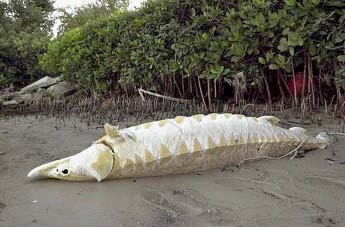
By LEANORA MINAI, Times Staff Writer
© St. Petersburg Times
published March 19, 2002
ST. PETERSBURG -- To the untrained eye, it is a large and strange-looking fish.
To scientists, it is a gem.
Marine biologists and others are dazzled over the discovery of the largest sturgeon found in the Tampa Bay area since 1897, and one of only a handful found here in the last century.
"It's truly a living relic," said Daniel Roberts, a research scientist at the Florida Marine Research Institute in St. Petersburg, where a necropsy was performed Monday on the sturgeon. "Most people have never seen any of these fish. They're very rare."
Now researchers are trying to learn how the fish got here. Did it take an incredibly bad turn, or are the prehistoric-looking creatures making a comeback in this region?
Biologists do not know what killed the sturgeon, which washed up Friday in a Shore Acres neighborhood.
The fish, a 40-year-old female, was plump with 10 pounds of ripe, black eggs -- high-quality caviar, which would have brought an estimated $6,500.
Marine biologists are curious about the origin of this particular fish. They have long believed the sturgeon, plentiful in the Gulf of Mexico before 1900, disappeared from the Tampa Bay area.
"We have been assuming that the Tampa Bay stocks are gone," said Roberts, 52, also director of a sturgeon habitat study by the Florida Fish and Wildlife Conservation Commission. "We just thought there weren't any more, that they couldn't live here anymore, and to find one, especially a big ripe female, is exciting."
In the late 1800s, more flesh and caviar from sturgeon was harvested in Tampa Bay than any other fishery port in the Gulf of Mexico, including New Orleans. Since then, the sturgeon has been threatened with extinction, killed off by overfishing, dams and pollution.
Sturgeon are known to migrate from January to April and spawn in freshwater -- the Mississippi, Pearl, Escambia, Yellow, Choctawhatchee, Apalachicola and Suwannee rivers.
Biologists have tagged and monitored sturgeon to determine where the fish go when they leave freshwater spawning grounds.
"We've never found a spawner in a river that flows into Tampa Bay," Roberts said.
That makes Roberts wonder whether this fish was headed to reproduce at a river that feeds Tampa Bay -- the Alafia or Hillsborough. That would be a first.
"I think it would add a renewed significance and be a measure of sorts of environmental protection," Roberts said. "It would give us some hope that the things we're doing to protect our environment may actually be working to some small degree."
Roberts also said this particular fish might have strayed, taken a wrong turn and gotten lost on her way to spawn in the Suwannee River, where a healthy population of sturgeon exists. Sturgeon are docile and swim and feed on the bottom in water 3-feet to hundreds of feet deep.
After Monday's necropsy, Roberts still does not know why the fish died but hopes that after studying tissue samples, he will be able to determine whether it is from the Suwannee River species.
"We would like to know the history of this fish," Roberts said. "Where did it come from? And why is it in Tampa Bay during the spawning season?"
Part of an old monitoring tag was found on the 40-year-old fish, suggesting it was being tracked by scientists at one time. The fish also had a small hole under its belly. "It could have been a spear," Roberts said.
Still, Roberts does not believe a fisherman tried to kill the sturgeon for its flesh and caviar.
"Maybe it got hooked up or tied up in a fish net," Roberts said. "It didn't look like it had been hit by a boat. It didn't have any shark bites on it. . . . It's a fish tale."
Sturgeon are the oldest living
species
of fish, dating back more than 250-million years. They existed at the
same
time as the dinosaurs and have been described as "living fossils."
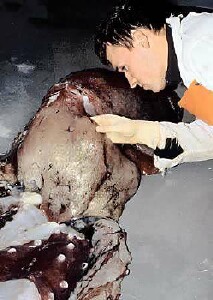
WELLINGTON (Reuters) - Scientists have identified what they believe is the largest octopus ever seen, a 13 foot long giant hauled from the depths near New Zealand's remote Chatham Islands.
The dead specimen, caught in a trawler's net, was badly damaged but it was clearly a massive animal, National Institute of Water and Atmospheric Research (NIWA)marine biologist Steve O'Shea.
"It would easily have been four-plus meters in total length and a weight of 70-75 kg (154-165 pounds), if not more -- it's a very big octopus, the size of a fully mature male giant squid." O'Shea had provisionally identified the specimen, caught at a depth of more than 3,000 feet, as Haliphron Atlanticus, a bright red, jelly-like species of octopus not previously found in the South Pacific.
Juveniles of the species had been found in shallow northern waters, with adults believed to live at a depth of around 250 meters so the discovery (news - web sites) was unusual, he said.
"It's extremely deep, it's extremely large, it's the first recorded in the South Pacific, it may not even be the species we've attributed to it at this point in time -- I've got a lot more work to do on it."
People had been amazed when he relayed the details of the creature, O'Shea said.
"But down here in New Zealand, this is an area which is so poorly explored that its not surprising that we're getting all these weird and wonderful animals.
"The frightening thing is that we are getting an animal like this newly reported in New Zealand waters today...so new and large, you've got to sit down and ask yourself 'What is it we know about the deep sea environment?'," O'Shea said.
Octopuses are one of the most diverse creatures on earth, with several hundred species worldwide and more than 40 species found in New Zealand waters alone.
The Chathams are a windswept group
of
islands around 530 miles east of Christchurch, home to around 800
people
engaged in sheep farming and fishing.
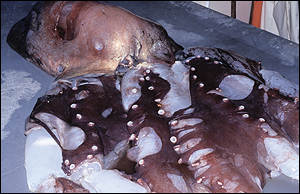
By Kim Griggs
in Wellington, New Zealand
What is thought to be the biggest
octopus
ever found has been caught in waters off New Zealand.
Then I had a freezer clean-out and I
had no idea what it was
Dr Steve O'Shea, NIWA
Marine biologist Dr Steve O'Shea
estimates
the specimen, which was damaged when fished up, would have measured
four
metres in length and weighed 75 kilograms.
"That's a conservative estimate," Dr O'Shea told BBC News Online. "It is an absolutely massive octopus."
The incomplete specimen has a mantle length (the standard measure of length in octopus and squid) of 0.69 metres, a total length of 2.9 metres and a weight of 61 kg.
Not a squid
Octopus (Haliphron) had previously been thought to reach a mantle length of only 0.4 metres and a total length of 2 metres.
Dr O'Shea does not think this animal
is native to New Zealand waters
"Nothing remotely comparable to the
size of the New Zealand specimen has ever been described before," Dr
O'Shea
said.
The octopus was caught last October in 920 metres of water south east of the Chatham Islands, by the research ship of New Zealand's National Institute of Water and Atmospheric Research (NIWA).
At first, Dr O'Shea paid little attention to the red gelatinous specimen, thinking it was just another example of his research specialty, the giant squid.
Freezer clear-out
"I have a freezer full of squid. And I looked at this and I just thought, 'Heavens, it's a pretty beat up sort of squid'. And I wasn't in any hurry to defrost it. Then I had a freezer clean-out and I had no idea what it was."
He has provisionally identified the sub-mature female as being Haliphron atlanticus. Adding to the mystery, this particular species has never been caught before in the South Pacific.
There are some records from around Japan, Papua-New Guinea and from the Atlantic. "The New Zealand form that we have is more similar to a species which was recorded off Japan in 1902 than it is to the Atlantic species.
"So although I call it Haliphron atlanticus, that's a very provisional identification."
Splendid sight
Dr O'Shea is also puzzled by the fact the New Zealand research institute has never seen juveniles of this species in New Zealand waters.
This is despite the fact that the area where the octopus was found is extensively trawled by commercial fishing vessels and unusual specimens are routinely passed to NIWA.
"I don't believe that this animal is residing in New Zealand at all. It could have been something that's migrated in from spectacular depth.
"Not only is it not residing in New Zealand waters, I don't believe we get the full life history of the species in New Zealand," he said.
The undamaged octopus would have been a splendid sight: all the arms would have been connected by a thick web.
"It would have looked like a huge jellyfish or a great big thick umbrella," Dr O'Shea said.
A strange new life form has been discovered in the depths of the ocean off the north-east coast of Iceland.
The bugs belong to an entirely new group of microbes and are probably the smallest living things on Earth.
At a mere 400 millionths of a millimetre across, more than six million would fit on the head of a pin.
The microbes are classified as Archaea - one of the three giant branches of life that also include bacteria and eukaryotes, organisms with cell nuclei. Archaea are genetically different from bacteria and many are "extremophiles" that live in the most extreme environments on Earth.
But although Archaea include some very strange primitive life forms, the new group is odder than anything found before and thought to comprise a new category within the domain. Named Nanoarchaeum equitans, the spherical bugs live on the surface of a much bigger Archael organism, Ignicoccus.
German scientists led by Karl Stetter at the University of Regensburg found them 120 metres under the sea off Iceland, in a place where volcanic activity heats the water close to boiling point. The Nanoarchaeota appear to be reliant on their host microbe and unable to survive on their own.
But what the relationship is between the two remains a mystery. Writing in the journal Nature, the scientists say the tiny bugs are clearly not preying on Ignicoccus as parasites.
The two organisms probably lived a symbiotic existence, which meant each was dependent on the other - but how is not known. Direct contact with Ignicoccus appears to be necessary for Nanoarchaeota to grow.
Discussing the discovery in Nature, evolutionary biologist Ford Doolittle and Yan Boucher from Dalhousie University, Halifax, Canada, refer to Nanoarchaeum as "an exciting new creature".
They said: "Although invisible to the naked eye, it is as worthy of our notice as any coelacanth or other macroscopic 'living fossil'."
Scientists Find Evidence Sea Extended to Loch Ness on Two Occasions
British and U.S. scientists claim they have evidence that the sea
extended
into Loch Ness at two points in history: after the Ice Age
in Europe
(125,000 years ago) and 12,800 years ago. A geologist working
with a
research team in 2001 noticed the clay on the anchor of their boat
looked
different from other deposits found in the same part of the
Loch.
Carbon
dating and amino-acid testing on the clay indicated that it
contained
clams
and sea urchin spines from both 12,800 and 125,000 years ago.
This discovery would tend to lend credence to the theory that
large
animals
could have become trapped in the Loch as the water receded back
to the sea.
Skeptics have traditionally argued that no monster could exist in
Loch Ness
because it has always been a body of fresh water.
Source: The Press and Journal (North Scotland)
submitted by CurlyJoe@theshadowlands.net
On May 1, a local resident named Barbara Malloy reported seeing a
hump bobbing up and down n the water. It was described as being
jet
black in colour. This was Malloy's second sighting of Lake
Memphremagog's
most
unusual resident - she had also reported a sighting in 1983.
"Memphre", as this creature is affectionately known, is said to
resemble
a plesiosaur (four fins, a long neck, and an elongated body).
Various
witnesses have estimated the length to be between 6 and 50 feet and it
is said to be brown, black, or green in colour.
Source: The Caledonian-Record
submitted by CurlyJoe@theshadowlands.net
Lake Tianchi Monster Surfaces in China
It seems that China is home to its own version of the Loch Ness
Monster.
On July 11, 2003, witnesses were treated to a group of unknown
creatures
swimming in the Lake. As many as 20 of the animals were seen in
the
Lake at a distance of between two and three kilometers. The
witnesses,
a group of government officials, saw white or black spots that created
ripples in the
water.
A witness to a previous sighting reportedly saw a grey-skinned animal with a long neck (1.2-1.5 metres long) and a white ring around its neck (separating the neck and torso). The head had large eyes and a protruding mouth.
Source: Reuters (Sydney Morning Herald)
submitted by CurlyJoe@theshadowlands.net
In June of 2003, scientists conducting research on Lake
Champlain's
resident monster for the Discovery Channel were shocked when their
underwater
microphones picked up sounds very similar to those of dolphins or Beluga
whales. These ticks and chirps offer compelling evidence that
Champ is very real. Certainly, legislators in New Hampshire and
Vermont
must think so laws have been passed in both states to stop
hunters
from harassing the
creature.
Even P.T. Barnum was interested in Champ - in the 1800's he offered a $50,000 reward for recovery of the animal (dead or alive). Despite the efforts of several would-be Champ hunters, the money remained unclaimed.
Source: The Boston Globe
submitted by CurlyJoe@theshadowlands.net
"Cressie" Sighted in Newfoundland
Crescent Lake, located 400 kilometers west of St. John's,
Newfoundland,
appears to have its own version of the Loch Ness Monster.
Sightings
of "Cressie" have taken place several times over the last 50
years.
No Cressie
sightings were reported in 2002, leading residents to wonder if
perhaps the animal had died. But Cressie, described by witnesses
as being a "snake-like creature with a fish-like head", resurfaced in
the
summer of 2003.
Source: CBC News
submitted by CurlyJoe@theshadowlands.net
Plesiosaur Fossil Found in Loch Ness - Senior Citizen Stumbles on Find
Gerald McSorley, of Stirling, lost his footing near the bank of
Loch
Ness and put down his hand to steady himself. He noticed
something
unusual in the water and picked it up. When the algae was removed
from the object, he
found himself staring at four vertebrae, including spinal cord and
blood vessels, encased in limestone.
The curator of the National Museum in Edinburgh confirmed the
find
was indeed part of an adult plesiosaur. The fossil would be
between
150 and 155 million years old. Nessie hunters will now comb the
area
for further
fossilized remains.
Source: BBC News
submitted by CurlyJoe@theshadowlands.net
Saskatchewan's Turtle Lake Monster
Turtle Lake (120 km/74 miles) to the northwest of North
Battlefield)
appears to have a mysterious inhabitant. Eyewitness accounts vary
with respect to length (10-30 feet), skin texture (smooth or scaly) and
shape of the head
(described as resembling a seahorse, dog, or pig).
The "monster" has been spoken of in the area for centuries - Indian legend has it that anyone foolish enough to intrude on its territory would not return.
While some have theorized that the Lake's unknown inhabitant is a giant sturgeon, others feel that this is unlikely due to the fact that sturgeons are bottom-dwellers who are not likely to be spotted at the water's surface.
Another theory contends that the mysterious creature is a descendent of one of the plesiosaurs which lived in the region millions of years ago, when Saskatchewan was covered by an inland sea.
Which theory is correct? Perhaps time (and one lucky fisherman who captures the beast) will tell.
submitted by CurlyJoe@theshadowlands.net
"Sea Monster" Sighting Reported by Nova Scotia Fisherman
In the early summer of 2003, Wallace Cartwright was headed out to
sea to check his lobster traps. The native of Alder Point, Cape
Breton
County, saw what he thought was a big log in the water. The "log"
had a head similar to
a sea turtle with a brown, snake-like body. It was
approximately
eight metres long, brown with smooth skin. The creature submerged
and surfaced again two minutes later.
Cartwright and his assistant observed the animal for 45 minutes as it surfaced several more times. Mr. Cartwright, who has been a fisherman for 30 years, stated that what he had seen was unlike anything he had ever encountered before.
Andrew Hebda, curator of zoology at Halifax's Natural History
Museum,
is of the opinion that what Mr. Cartwright observed was an
oarfish.
The oarfish is normally found in the waters north of Great Britain;
this
particular
specimen probably followed a frigid ocean current to the waters
off Cape Breton.
Oarfish are nature's longest fish. They have been known to reach up to 17 metres in length.
submitted by CurlyJoe@theshadowlands.net
"Bloop" Recorded by U.S. Navy - "Most Likely Biological in Nature"
A mysterious recording, picked up by "spy sensors" put in place by the U.S. Navy in the 1960's, has recently been made public. Dubbed "Bloop" by scientists, the unidentified sound is similar to those made by marine animals. Bloop, however, is larger than any known animal.
One theory is that Bloop is a giant squid. This animal has never been observed in the wild, although dead squid have been found washed up on beaches. Including its tentacles, the largest dead squid on record measured 60 feet.
Marine biologists have disputed this theory, explaining that since squid lack a gas-filled sac, they have no way of making that type of noise.
The identity of Bloop remains an unsolved mystery.
submitted by CurlyJoe@theshadowlands.net
Monster Shark Attacks
Great White
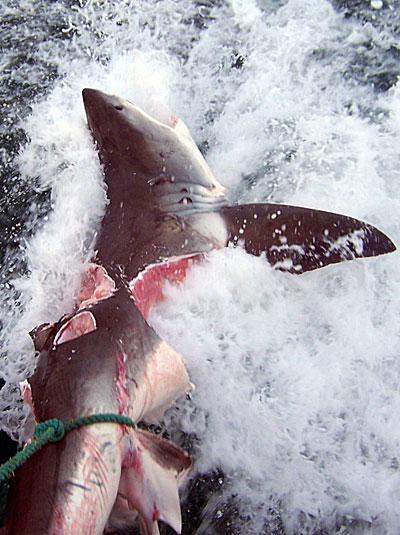
Tuesday
October 27, 2009
Huw Borland, Sky News Online
Experts
said its rival may be 20ft (about six metres) long, judging by the size
of the huge bites.
The
great white was savaged after it got snared on a drum line - a baited
hook attached to a buoy - near North Stradbroke Island, east of
Brisbane.
The wounded creature was still alive when a crew hauled it onto a boat,
close to Deadman's Beach.
"It
certainly opened up my eyes. I mean the shark that was caught is a
substantial shark in itself," Queensland Fisheries' Jeff Krause told
Australia's Daily Telegraph.
Swimmers
have been warned to stay out of the water near the island.
The
attack also worried many at a nearby tourist Mecca - Surfers Paradise,
south of Brisbane.
Surfer
Ashton Smith, 19, of the Gold Coast, told the Courier Mail: "I've heard
about the big one lurking. Every surfer is always cautious over here."
Drum
lines and shark nets are used to defend swimmers from sea predators,
but they have been criticised for occasionally trapping migrating
whales.
Fisheries
minister Tim Mulherin told the Mail that the
capture of the bitten shark - and the indication of a larger one
feeding in the area - bolstered the decision to keep defences in place.
He
added there were no special plans to hunt the attacking shark but
contractors had reset the drum lines.
The Loch Ness Monster Research Society
The Original Loch Ness Monster Exhibition Centre
Coelacanth Rescue Mission Great Site!
NAHUELITO creature in Patagonian Lake
UNKNOWN CARCASSES WASHING ASHORE
THE SWEDISH LAKE MONSTER & ALOT MORE
UNKNOWN SEA CREATURE OFF OF KUWAIT
Swedish Lake searched for creature
Article on recent Loch Ness search


Links2Go Key Resource Cryptozoology Topic |
The images on this page were obtained from publicly available sources, and to the best of our knowledge, the images are in the public domain. If you own the copyright on any image on this page, and you would like us to remove it, please identify yourself and the image, and we will. If you own the copyright and you are willing to give us permission to use the image, we would like to know that also.
© 2010 davejuliano@theshadowlands.net